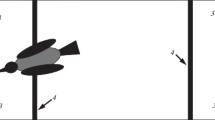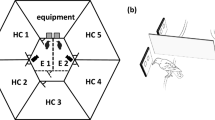Abstract
Four gray crows were trained to choose the larger of two sets presented to them within the “1–12” range. The color, form, and size of the stimulus elements on cards, as well as the patterns of their disposition, were varied constantly during training, while at the same time prohibiting the use of extraneous features not relating to the number of elements. In order to exclude choice on the basis of the total area of the elements, series of presentations with variation of the ratio of the number of elements and their total area were carried out: in half of the presentations the larger set consisted of small elements, and the smaller set of large elements; in the second half, the reverse. In this range all of the birds demonstrated a high accuracy of evaluations (75.3±2.4%), including when there were minimal differences between the sets to be compared. Thus, in the “1–12” range, the crows were found to be capable of accurately comparing sets precisely on the basis of the number of elements in them. When a transition was made to a new “10–20” range, all of the crows demonstrated a successful transfer of the developed reaction (71.5±2.3%). However, when the ratio of the number of elements and their total area was varied, only two birds were able to cope with this task (71.9±3.6%). Overall, the results obtained indicate a capacity of crows for the formation of the concept “larger set,” and are regarded as a manifestation of a high level of development of reflective activity.
Similar content being viewed by others
References
Z. A. Zorina, “Comparative investigations of some complex forms of learning in birds,” in: Comparative Physiology of Higher Nervous Activity of Man and Animals [in Russian], Nauka, Moscow (1990), p. 21.
Z. A. Zorina, T. S. Kalinina, M. E. Maiorova, et al., “Relative quantitative evaluations in crows and pigeons in unexpected comparison of stimuli, previously associated with different amounts of reinforcement,” Zh. Vyssh. Nervn. Deyat.,41, No. 2, 306 (1991).
Z. A. Zorina, Reflective Activity in Birds, Diss. ... Doctor of Biol. Sciences, MGU, Moscow (1993).
Z. A. Zorina and A. A. Smirnova, “Relative quantitative evaluations in crows and pigeons; spontaneous choice of a larger food set,” Zh. Vyssh. Nervn. Deyat.,44, No. 3, 618 (1994).
L. V. Krushinskii, The Biological Bases of Reflective Activity [in Russian], Nauka, Moscow (1986).
L. Lévi-Bruhl, Primitive Thinking (1930), p. 121.
V. S. Nikitin and L. A. Firsov, “The organization of complex forms of mnestic activity in monkeys,” in: The Mechanisms of Adaptive Behavior [in Russian], Nauka, Moscow (1986), p. 38.
S. T. Boysen and G. G. Berntson, “Numerical competence in a chimpanzee (Pan troglodytes),” J. Compar. Psychol.,103, 23 (1989).
R. G. Cooper, “Early number space with addition and subtraction” in: Origins of Cognitive Skills, C. Sofhian (ed.), Erlbaum (1984).
H. Davis, “Discrimination of the number three by a raccoon (Procion lotor),” Animal Learn. Behav.,12, 409 (1984).
H. Davis and R. Perusse, “Numerical competence in animals; definition issues, current evidence, and a new research agenda,” Behav. Brain Sci.,11, 561 (1988).
G. B. Dooley and T. Gill, “Mathematical capabilities in Lana chimpanzee,” in: Progress in Ape Research, G. H. Bourne (ed.), Academic Press, New York (1977).
R. Gelman and C. R. Gallistel, The Child's Understanding of Number, Harvard University Press (1978).
L. N. Hicks, “An analysis of number-concept formation in the rhesus monkey,” J. Comp. Physiol. Psychol.,49, 212 (1956).
O. Koehler, “Le dénombrement chez les animaux,” J. Comp. Psychol. Norm. Pathol.,57, 39 (1960).
G. Lin, Y. Wang, and H. Yang, “Sameness-difference judgments of numerousness by monkeys: Macacca mulatta and Macacca assamensis,” The International Journal of Comparative Psychology,3, 245 (1990).
I. M. Pepperberg, “Evidence for conceptual abilities in the African grey parrot (Psittacus erithacus): Labeling of cardinal sets,” Ethology,75, 37 (1987).
D. M. Rumbaugh, E. S. Savage-Rumbaugh, and M. T. Hegel, “Summation in the chimpanzee (Pan troglodytes),” J. of Experim. Psychol.: Animal Behavior Processes,13, 107 (1987).
L. P. Steffe, P. Cobb, and E. von Glasersfeld, The Construction of Arithmetical Meanings and Strategies, Springer-Verlag (1988).
R. K. Thomas, D. Fowlkes, and J. D. Vickery, “Conceptual numerousness judgements by squirrel monkeys,” Am. J. Psychol.,93, 247 (1980).
R. K. Thomas and L. Chase, “Relative numerousness judgements by squirrel monkeys,” Bull. of the Psychonomic Soc.,16, 79 (1980).
Additional information
Institute of Higher Nervous Activity and Neurophysiology, Russian Academy of Sciences, Moscow. Translated from Zhurnal Vysshei Nervnoi Deyatel'nosti imeni I. P. Pavlova, Vol. 45, No. 3, pp. 490–499, May–June, 1995.
Rights and permissions
About this article
Cite this article
Zorina, Z.A., Smirnova, A.A. Quantitative evaluations in gray crows: Generalization of the relative attribute “larger set”. Neurosci Behav Physiol 26, 357–364 (1996). https://doi.org/10.1007/BF02359040
Received:
Revised:
Issue Date:
DOI: https://doi.org/10.1007/BF02359040




